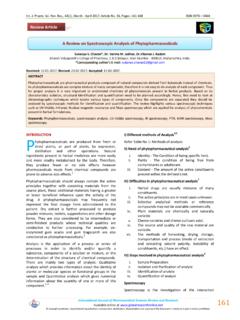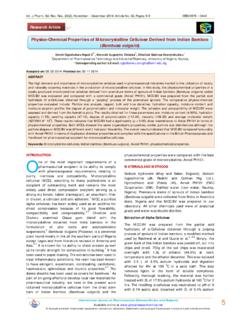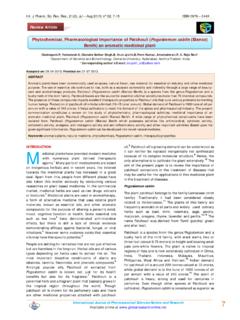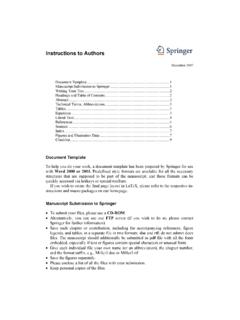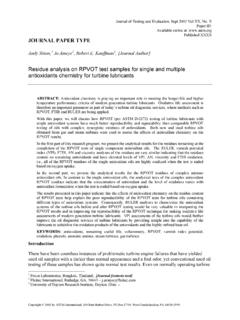Transcription of Research Article - International Journal of …
1 Int. J. Pharm. Sci. Rev. Res., 27(2), July August 2014; Article No. 45, Pages: 272-278 ISSN 0976 044X International Journal of Pharmaceutical Sciences Review and Research Available online at Copyright protected. Unauthorised republication, reproduction, distribution, dissemination and copying of this document in whole or in part is strictly prohibited. Copyright protected. Unauthorised republication, reproduction, distribution, 272 Nita Yadava*, Rajesh Yadava, Anju Goyalb a*Department of Pharmacy, SRMS, College of Engg. and Tech, Bareilly, , India. bDepartment of Pharmaceutical Sciences, College of Pharmacy, Udaipur, Rajasthan, India. *Corresponding author s E-mail: Accepted on: 25-05-2014; Finalized on: 30-06-2014. ABSTRACT Plant terpenoids are used extensively for their aromatic qualities.
2 They play a role in traditional herbal remedies and are under investigation for antibacterial, antineoplastics, and other pharmaceutical functions. Plants do not only accumulate terpenes for herbivore defense, but also emit volatile blends in response to herbivory and many other biotic and abiotic stresses. These terpene-containing volatiles attract natural enemies of the attacking herbivores but due to the complexity of these volatile blends, it is difficult to attribute a specific function to a particular terpene. The importance of terpenes in both nature and human application is difficult to overstate. Basic knowledge of terpene and isoprene biosynthesis and chemistry has accelerated the pace at which scientists have come to understand many plant biochemical and metabolic processes.
3 The abundance and diversity of terpene compounds in nature can have ecosystem-wide influences. Although terpenes have permeated human civilization since the Egyptians, terpene synthesis pathways are only now being understood in great detail. The use of bioinformatics and molecular databases has largely contributed to analyzing exactly how and when terpenes are synthesized. The steroids and sterols in animals are biologically produced from terpenoid precursors. Sometimes terpenoids are added to proteins, , to enhance their attachment to the cell membrane; this is known as isoprenylation. Keywords: Isoprene, Isolation, Secondary metabolites, Spectroscopic methods and structure elucidation, Terpenes. INTRODUCTION here are many different classes of naturally occurring compounds. Terpenoids also form a group of naturally occurring compounds majority of which occur in plants, a few of them have also been obtained from other sources.
4 Terpenoids are volatile substances which give plants and flowers their fragrance. They occur widely in the leaves and fruits of higher plants, conifers, citrus and The term terpene was given to the compounds isolated from terpentine, a volatile liquid isolated from pine trees. The simpler mono and sesquiterpene is chief constituent of the essential oils obtained from sap and tissues of certain plant and trees. The di and tri terpenoids are not steam volatile. They are obtained from plant and tree gums and resins. Tertraterpenoids form a separate group of compounds called Carotenoids . The term terpene was originally employed to describe a mixture of isomeric hydrocarbons of the molecular formula C10H16 occurring in the essential oils obtained from sap and tissue of plants, and trees.
5 But there is a tendency to use more general term terpenoids which include hydrocarbons and their oxygenated derivatives. However the term terpene is being used these days by some authors to represent By the modern definition: Terpenoids are the hydrocarbons of plant origin of the general formula (C5H8)n as well as their oxygenated, hydrogenated and dehydrogenated derivatives. Isoprene rule Thermal decomposition of terpenoids give isoprene as one of the product. Otto Wallach pointed out that terpenoids can be built up of isoprene Isoprene rule states that the terpenoid molecules are constructed from two or more isoprene unit. Isoprene unit Further Ingold suggested that isoprene units are joined in the terpenoid via head to tail fashion. Special isoprene rule states that the terpenoid molecule is constructed of two or more isoprene units joined in a head to tail But this rule can only be used as guiding principle and not as a fixed rule.
6 For example carotenoids are joined tail to tail at their central and there are also some terpenoids whose carbon content is not a multiple of five. In applying isoprene rule we look only for the skeletal unit of carbon. The carbon skeletons of open chain monoterpenoids and sesquiterpenoids are, Chemistry of TerpenoidsTResearch Article Int. J. Pharm. Sci. Rev. Res., 27(2), July August 2014; Article No. 45, Pages: 272-278 ISSN 0976 044X International Journal of Pharmaceutical Sciences Review and Research Available online at Copyright protected. Unauthorised republication, reproduction, distribution, dissemination and copying of this document in whole or in part is strictly prohibited. Copyright protected. Unauthorised republication, reproduction, distribution, 273 Examples Myrcene (monoterpene) Farnesol (Sesquiterpene) Ingold (1921) pointed that a gem alkyl group affects the stability of terpenoids.
7 He summarized these results in the form of a rule called gem dialkyl rule which may be stated as Gem dialkyl group tends to render the cyclohexane ring unstable where as it stabilizes the three, four and five member rings. This rule limits the number of possible structure in closing the open chain to ring structure. Thus the monoterpenoid open chain give rise to only one possibility for a monocyclic monoterpenoid the p-cymene structure. P-cymene structure Bicyclic monoterpenoids contain a six member and a three member ring. Thus closure of the ten carbon open chain monoterpenoid gives three possible bicyclic structures. Camphor(6+5) system Pinane(6+4) system Carane(6+3) System CLASSIFICATION OF TERPENOIDS Most natural terpenoids hydrocarbon have the general formula (C5H8)n.
8 They can be classified on the basis of value of n or number of carbon atoms present in the (Table-1) Each class can be further subdivided into subclasses according to the number of rings present in the structure. Acyclic Terpenoids: They contain open structure. Monocyclic Terpenoids: They contain one ring in the structure. Bicyclic Terpenoids: They contain two rings in the structure. Tricyclic Terpenoids: They contain three rings in the structure. Tetracyclic Terpenoids: They contain four rings in the structure. Table 1: Classification of Terpenoids Number of carbon atoms Value of n Class 10 2 Monoterpenoids (C10H16) 15 3 Sesquiterpenoids (C15H24) 20 4 Diterpenoids (C20H32) 25 5 Sesterpenoids (C25H40) 30 6 Troterpenoids (C30H48) 40 8 Tetraterpenoids (C40H64) >40 >8 Polyterpenoids (C5H8)n Some examples of mono, sesqui and di Terpenoids: Mono Terpenoids i) Acyclic Monoterpenoids Myrcene Citral Geraniol ii) Monocyclic monoterpenoids Limonene -Terpineol Menthol iii) Bicyclic monoterpenoids: These are further divided into three classes.
9 A) Containing -6+3-membered rings Thujane Carane b) Containing -6+4- membered rings Pinane Int. J. Pharm. Sci. Rev. Res., 27(2), July August 2014; Article No. 45, Pages: 272-278 ISSN 0976 044X International Journal of Pharmaceutical Sciences Review and Research Available online at Copyright protected. Unauthorised republication, reproduction, distribution, dissemination and copying of this document in whole or in part is strictly prohibited. Copyright protected. Unauthorised republication, reproduction, distribution, 274 c) Containing -6+5-membered rings Bornane (Camphane) non bornane (iso camphane) Some bicyclic monoterpenes are Camphor -pinene Sesquiterpenoids i) Acyclic sesquiterpenoids ii) Monocyclic sesquiterpenoids iii) Bicyclic sesquiterpenoids Farnesol Zinziberene Cadinene Diterpenoids i) Acyclic diterpenoids Phytol ii) Mono cyclic diterpenoids Vitamin A Isolation of Mono And Sesquiterpenoids12-13 Both mono and sesquiterpenoids have common source essential oils.
10 Their isolation is carried out in two steps: i) Isolation of essential oils from plant parts ii) Separation of Terpenoids from essential oils. i) Isolation of essential oils from plant parts The plants having essential oils generally have the highest concentration at some particular time. Therefore better yield of essential oil plant material have to be collected at this particular time. From jasmine at sunset. There are four methods of extractions of oils. a) Expression method b) Steam distillation method c) Extraction by means of volatile solvents d) Adsorption in purified fats Steam distillation is most widely used method. In this method macerated plant material is steam distilled to get essential oils into the distillate form these are extracted by using pure organic volatile solvents. If compound decomposes during steam distillation, it may be extracted with ether at 50oC.

